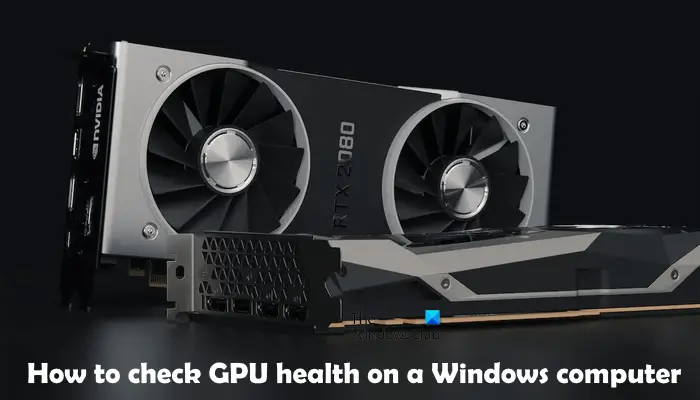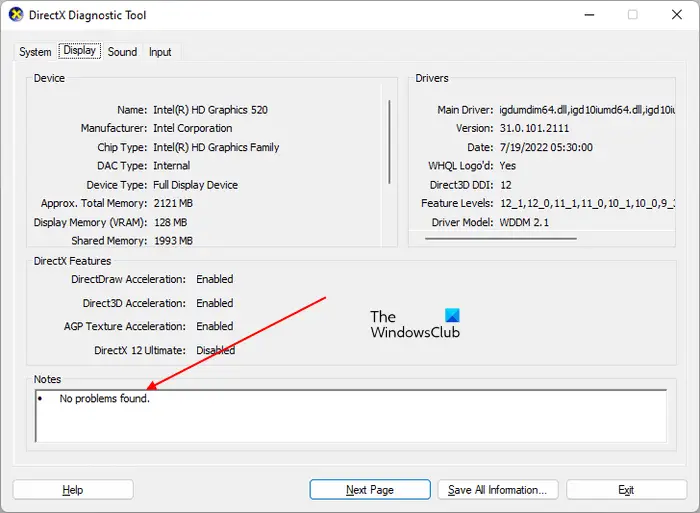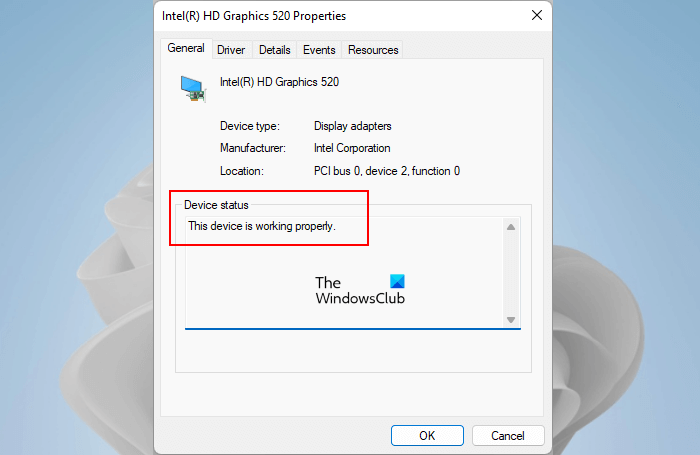A GPU or Graphics Processing Unit is one of the most important hardware for computer systems when it comes to graphics. Its main job is to process and render graphics. The quality of graphics in video games, movies, etc., depends on the graphics card. To display and render heavy graphics, your computer requires a heavy-duty graphics card. If you are a gamer, you better know the importance of graphics cards. Hence, it is important to keep your graphics card healthy. If your GPU keeps crashing or freezing or behaving oddly, then this article will show you how to check GPU health on a Windows computer.

How to check GPU health on a Windows computer
There are different methods by which you can check GPU health on a Windows Computer. Below, we have explained all these methods in detail.
- Using the DirectX Diagnostic Tool
- Using the Device Manager
- Via free GPU benchmarking software
- By monitoring the GPU temperature
Let’s start.
1] Check your GPU health by using the DirectX Diagnostic Tool
DirectX Diagnostic Tool is used to test DirectX functionality and troubleshoot sound and video-related hardware problems. You can also use it to check your graphics card health. The following steps will help you with that:

- Press the Win + R keys to launch the Run command box.
- Type dxdiag and click OK.
- The DirectX Diagnostic Tool will appear on your screen. Select the Display tab.
- You will see all the information about your GPU under this tab.
Under that Notes section, you will see the “No problems found” message if the tool does not detect any issues with your GPU.
Read: What is GPU Artifacting?
2] Check your GPU health by using the Device Manager
Another method to know whether your GPU’s health is fine or not is by using the Device Manager. The Device Manager lists all the drivers installed on your computer. Different hardware requires different drivers to function properly. Go through the following instructions:
- Press the Win + X keys and select the Device Manager.
- Expand the Display adapters node.
- Right-click on your graphics card driver and select Properties.
- See the Device status under the General tab.

If the Device status shows the “This device is working properly” message, your graphics card is in good health. If you see a warning or an error message there, there might be a software and hardware issue with your graphics card. But remember, the error or warning message in the Device Manager does not conclude that your GPU is damaged or malfunctioned.
It is also possible that its driver has been corrupted. Hence, before you jump to a conclusion, we suggest you reinstall your graphics card driver by downloading its latest version from the manufacturer’s website and then check again. A driver can be installed easily by double-clicking on it if it is downloaded in exe format. If the driver is in the INF file format, you have to use the Device Manager to install it.
If your graphics card is going to die, you will also see some signs that indicate that the health of your GPU is not good, and you need to take immediate action.
3] Check your GPU health using free GPU Benchmarking software
In computing, a benchmark is a test performed to analyze the performance of computer hardware, like CPU and GPU. Many free benchmarking programs are available online that you can download and install to perform benchmarking tests on your computer’s CPU and GPU. These benchmarking programs run a series of tests on the targeted hardware to measure its performance. You can also use these free benchmarking software to check your GPU health. Furmark and InfinityBench are some free benchmarking software for Windows 11/10.
Related: How to undervolt GPU? Is it good or bad to do so?
4] Monitor the GPU temperature
A healthy GPU always meets the requirements of the users by delivering optimum performance. The bad health of a GPU causes a decrease in its performance. The bad health can be due to software and hardware issues. For example, malfunctioning GPU components, like a heat sink, fans, etc., faulty cables that connect your GPU to your computer, corrupted GPU driver, or other software issues, etc.
Heat sinks and fans are among the most important hardware components of a GPU. When you do heavy graphics tasks on your system, the workload on a GPU increases. This increased workload also increases heat generation. Here comes the use of heat sinks and fans. Both of these components do their job to protect your GPU from damage due to excessive heat.
If any of these components stop working, you will experience frequent crashes while performing heavy graphics work on your system. A BSOD is an attempt by Windows to protect your hardware components from damage. When your computer reaches a condition where Windows can no longer operate safely, your system crashes with a Blue Screen. We suggest you monitor your GPU temperature to know whether it is healthy or not. You can use free software to monitor your GPU temperature.
It is normal for the GPU temperature to go high while performing heavy graphics work or while playing heavy graphics games. The temperature of healthy GPUs increases up to a certain limit and becomes stable after that. Also, if the heat sink or fans are not working properly, GPU adjusts the clock in order to reduce the heat. If your GPU health is not fine, the temperature will keep increasing which finally results in a system crash.
Related: How to underclock GPU? Is it safe to do so?
Some tips to keep your GPU healthy
GPU is an important piece of hardware for your computer, especially for those who play heavy graphics games and use heavy graphics software like Adobe Photoshop. Hence, it is necessary to keep it healthy for a long time. There are some tips that you should follow if you need a longer life span for your graphics card.
- Clean your graphics card at regular intervals of time. Cleaning is necessary to remove the dust accumulated on your GPU. Dust acts as the heat insulator and blocks the heat sink. Due to this, the temperature is not regulated properly. If you do not know how to clean a GPU, you should take professional help.
- Incorrect GPU settings also decrease the GPU’s health. If you have locked the fan limit or overclocked your graphics card, it will affect the health of your GPU. Overclocking a GPU can result in better performance but you should not overclock your GPU frequently.
Related: What is the difference between DDR3, DDR4, and DDR5 graphics cards?
What causes a faulty GPU?
There are several causes of graphics card failure. The main cause is the dust. If excessive dust is accumulated on your graphics card, it interferes with its components and also acts as a barrier for the heat sink. This results in excessive heat generation which causes a GPU failure.
Another cause is faulty components. If a hardware component of a GPU is damaged, it impacts its performance and reduces its life span. Frequent overclocking or keeping GPU in the overclocked state for a long time also affects its life span. In addition to this, frequent power surges can also damage your graphics card.
Can GPU be repaired?
A GPU can be repaired or not, it depends on the damage caused to it. In most cases, a graphics card can be repaired. If any of its components are damaged, the technician replaces that component. You should read what your GPU warranty covers so that you can know what types of damages are covered under its warranty.
I hope this helps.
Read next: How to find out which Graphics Card you have on your Windows.
Leave a Reply